Jack Beuth
Integrating Multi-Physics Simulations and Machine Learning to Define the Spatter Mechanism and Process Window in Laser Powder Bed Fusion
May 13, 2024



Abstract:Laser powder bed fusion (LPBF) has shown promise for wide range of applications due to its ability to fabricate freeform geometries and generate a controlled microstructure. However, components generated by LPBF still possess sub-optimal mechanical properties due to the defects that are created during laser-material interactions. In this work, we investigate mechanism of spatter formation, using a high-fidelity modelling tool that was built to simulate the multi-physics phenomena in LPBF. The modelling tool have the capability to capture the 3D resolution of the meltpool and the spatter behavior. To understand spatter behavior and formation, we reveal its properties at ejection and evaluate its variation from the meltpool, the source where it is formed. The dataset of the spatter and the meltpool collected consist of 50 % spatter and 50 % melt pool samples, with features that include position components, velocity components, velocity magnitude, temperature, density and pressure. The relationship between the spatter and the meltpool were evaluated via correlation analysis and machine learning (ML) algorithms for classification tasks. Upon screening different ML algorithms on the dataset, a high accuracy was observed for all the ML models, with ExtraTrees having the highest at 96 % and KNN having the lowest at 94 %.
Deep Learning for Melt Pool Depth Contour Prediction From Surface Thermal Images via Vision Transformers
Apr 26, 2024



Abstract:Insufficient overlap between the melt pools produced during Laser Powder Bed Fusion (L-PBF) can lead to lack-of-fusion defects and deteriorated mechanical and fatigue performance. In-situ monitoring of the melt pool subsurface morphology requires specialized equipment that may not be readily accessible or scalable. Therefore, we introduce a machine learning framework to correlate in-situ two-color thermal images observed via high-speed color imaging to the two-dimensional profile of the melt pool cross-section. Specifically, we employ a hybrid CNN-Transformer architecture to establish a correlation between single bead off-axis thermal image sequences and melt pool cross-section contours measured via optical microscopy. In this architecture, a ResNet model embeds the spatial information contained within the thermal images to a latent vector, while a Transformer model correlates the sequence of embedded vectors to extract temporal information. Our framework is able to model the curvature of the subsurface melt pool structure, with improved performance in high energy density regimes compared to analytical melt pool models. The performance of this model is evaluated through dimensional and geometric comparisons to the corresponding experimental melt pool observations.
Accelerating Process Development for 3D Printing of New Metal Alloys
Dec 29, 2023Abstract:Addressing the uncertainty and variability in the quality of 3D printed metals can further the wide spread use of this technology. Process mapping for new alloys is crucial for determining optimal process parameters that consistently produce acceptable printing quality. Process mapping is typically performed by conventional methods and is used for the design of experiments and ex situ characterization of printed parts. On the other hand, in situ approaches are limited because their observable features are limited and they require complex high-cost setups to obtain temperature measurements to boost accuracy. Our method relaxes these limitations by incorporating the temporal features of molten metal dynamics during laser-metal interactions using video vision transformers and high-speed imaging. Our approach can be used in existing commercial machines and can provide in situ process maps for efficient defect and variability quantification. The generalizability of the approach is demonstrated by performing cross-dataset evaluations on alloys with different compositions and intrinsic thermofluid properties.
Inexpensive High Fidelity Melt Pool Models in Additive Manufacturing Using Generative Deep Diffusion
Nov 15, 2023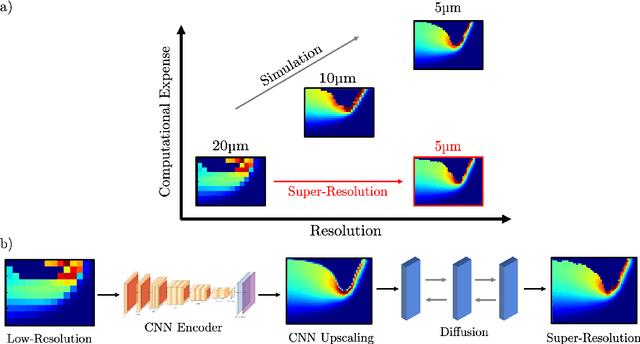

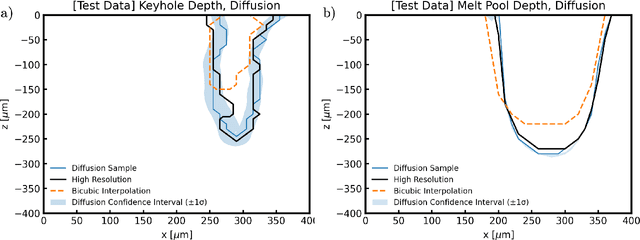
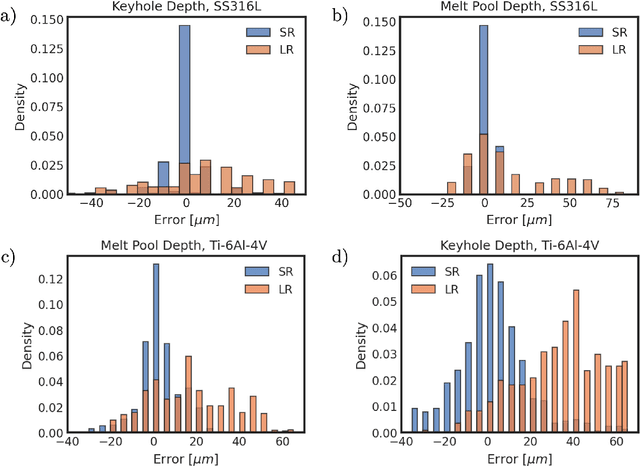
Abstract:Defects in laser powder bed fusion (L-PBF) parts often result from the meso-scale dynamics of the molten alloy near the laser, known as the melt pool. For instance, the melt pool can directly contribute to the formation of undesirable porosity, residual stress, and surface roughness in the final part. Experimental in-situ monitoring of the three-dimensional melt pool physical fields is challenging, due to the short length and time scales involved in the process. Multi-physics simulation methods can describe the three-dimensional dynamics of the melt pool, but are computationally expensive at the mesh refinement required for accurate predictions of complex effects, such as the formation of keyhole porosity. Therefore, in this work, we develop a generative deep learning model based on the probabilistic diffusion framework to map low-fidelity, coarse-grained simulation information to the high-fidelity counterpart. By doing so, we bypass the computational expense of conducting multiple high-fidelity simulations for analysis by instead upscaling lightweight coarse mesh simulations. Specifically, we implement a 2-D diffusion model to spatially upscale cross-sections of the coarsely simulated melt pool to their high-fidelity equivalent. We demonstrate the preservation of key metrics of the melting process between the ground truth simulation data and the diffusion model output, such as the temperature field, the melt pool dimensions and the variability of the keyhole vapor cavity. Specifically, we predict the melt pool depth within 3 $\mu m$ based on low-fidelity input data 4$\times$ coarser than the high-fidelity simulations, reducing analysis time by two orders of magnitude.
Surrogate Modeling of Melt Pool Thermal Field using Deep Learning
Aug 04, 2022
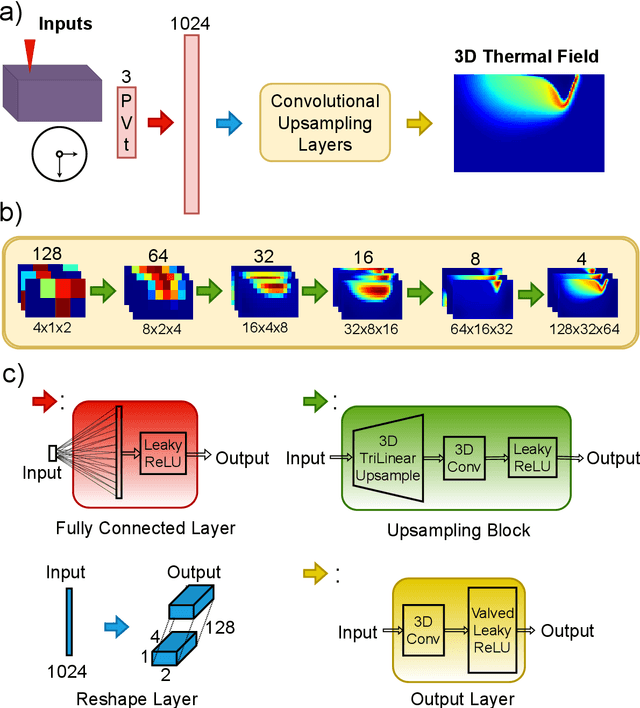
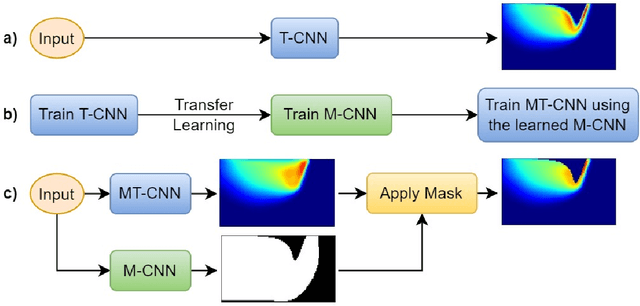

Abstract:Powder-based additive manufacturing has transformed the manufacturing industry over the last decade. In Laser Powder Bed Fusion, a specific part is built in an iterative manner in which two-dimensional cross-sections are formed on top of each other by melting and fusing the proper areas of the powder bed. In this process, the behavior of the melt pool and its thermal field has a very important role in predicting the quality of the manufactured part and its possible defects. However, the simulation of such a complex phenomenon is usually very time-consuming and requires huge computational resources. Flow-3D is one of the software packages capable of executing such simulations using iterative numerical solvers. In this work, we create three datasets of single-trail processes using Flow-3D and use them to train a convolutional neural network capable of predicting the behavior of the three-dimensional thermal field of the melt pool solely by taking three parameters as input: laser power, laser velocity, and time step. The CNN achieves a relative Root Mean Squared Error of 2% to 3% for the temperature field and an average Intersection over Union score of 80% to 90% in predicting the melt pool area. Moreover, since time is included as one of the inputs of the model, the thermal field can be instantly obtained for any arbitrary time step without the need to iterate and compute all the steps
 Add to Chrome
Add to Chrome Add to Firefox
Add to Firefox Add to Edge
Add to Edge